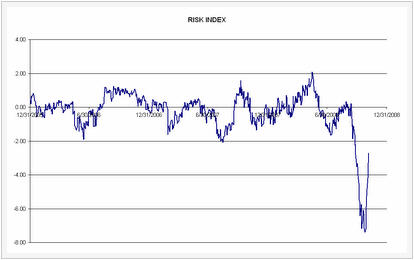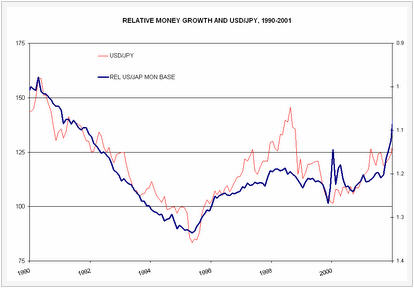So at last, the election is over. After weeks of facing accusations of being an Obama supporter in the office and an Obama hater in cyberspace, Macro Man can go back to focusing exclusively on markets and macro.
Markets seem to be in some sot of weird limbo at the moment. The acute feeling of crisis seems to have passed, yet has hardly given way to any sort of euphoria. As is generally the case, the slow grind higher is the most painful follow-through to a drop down the elevator shaft.
Anyone left long vol has probably not had a good week; Macro Man had the uncomfortably surreal experience of being long USD/JPY upside and losing money yesterday even as spot rallied a percent from his marks on Monday. Someone summon the Weather Girls, because it’s raining options.
The problem at the moment is perhaps encapsulated by the chart below, which shows the risk appetite index that Macro Man follows. Last month it went nearly eight standard deviations into risk aversion, a level that eclipsed even the panic readings of October 1987. And while it has retraced much of the move into risk aversion, it still sits a level more than two standard deviations below neutrality- in normal circumstances an extreme reading. These normalizations are always painful if you’re left long vol, and this wee has been no exception.
Looking ahead, it is reasonable to conjecture what an Obama administration might mean for the dollar. He’s already been more bullish for the dollar than Bush, insofar as the dollar came under immediate, significant selling pressure the day after Election Day 2004. EUR/USD has had the temerity to decline 1% today (albeit after a sharp yesterday.)
More broadly, it is probably legitimate to consider how the array of measures being conducted by the Fed will impact the dollar. The quantitative easing currently underway- and let’s face it, that’s what’s going on here- is significantly expanding the money supply, which a priori could be construed as bearish for the dollar.
And at first glance, the argument would appear to hold water. The chart below shows USD/JPY overlaid with the evolution in the relative sizes of the monetary bases in the US and Japan. And as you can see, the relationship appeared to explain a good deal of the swings and roundabouts in USD/JPY from 1990-2001, when Japan pursued orthodox policy measures to (unsuccessfully) combat its domestic depression/deflationary spiral.
In 2002, however, the BOJ adopted a radical policy of quantitative easing, which drastically exapnaded the BOJ’s balance sheet and, by extension, the monetary base. And what happened to the yen? Not a whole lot. Based on a similar scale to the chart below, a simple overlay would suggest that the yen should have weakened to nearly 200 vs the dollar. Instead, it went broadly nowhere.
Why is this? Primarily because this “new money” generated by quantitative easing a) went to offset money that disappeared as non-performing assets were written down, and thus stayed on banks’ balance sheets, and b) the remainder was placed with the BOJ.
It was only in 2005, when conditions began to fall into place to encourage the end of quantitative easing, that the wall of money (both institutional and Mrs. Watanabe) began to leave Japan.
This is a not dissimilar outcome to EUR/USD in the early Noughties; the dollar only really began to weaken dramatically when the economy started to pick up noticably and policy began to look demonstrably easy.
Macro Man can’t shake the belief, therefore, that while the current alphabet soup of measures might undermine the dollar….that might be a story for the next Administration, whoever it may be.
- Bulenox: Get 45% to 91% OFF ... Use Discount Code: UNO
- Risk Our Money Not Yours | Get 50% to 90% OFF ... Use Discount Code: MMBVBKSM
Disclaimer: This page contains affiliate links. If you choose to make a purchase after clicking a link, we may receive a commission at no additional cost to you. Thank you for your support!





Leave a Reply